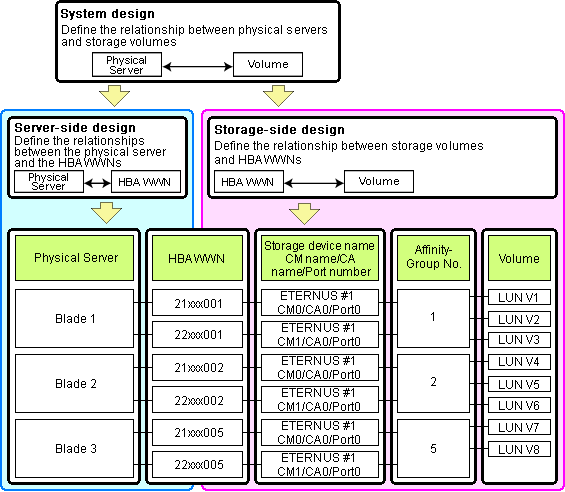System configuration requires that the relationship between physical servers and HBA WWNs from the perspective of the server, and the relationship between storage volumes and HBA WWNs from the perspective of storage devices be defined clearly.
An example where blades connect to storage devices via multiple paths using two HBA ports is shown below.
Refer to the storage device manual of each storage device for details.
Note
For server switchover using the HBA address rename method, only configurations with two or less HBA ports on the managed server are supported.
For server switchover using the storage affinity switchover method, only configurations with eight or less HBA ports on the managed server are supported.
Figure 10.1 WWN System Design

Choosing WWNs
When using HBA address rename, VIOM, or ISM, choose the WWNs to use.
After WWNs have been chosen, associate them with their corresponding operating systems (applications) and physical servers (on the server side), and with the corresponding volumes (on the storage side).
Using HBA address rename, VIOM, or ISM, the storage-side settings can be defined without prior knowledge of the actual WWN values of the HBAs of servers. This makes it possible to design a server and storage system without having the involved physical servers on hand.
When HBA address rename or ISM is used, the values provided by the "I/O virtualization option" are used as the WWN.
When VIOM is used, set either of the following for each WWN value:
The value provided by the "I/O virtualization option"
The value selected automatically from the address range at VIOM installation
To prevent data damage by WWN conflict, you are advised to use the value provided by "I/O virtualization option".
Information
Specify the unique WWN value provided by the "I/O virtualization option". This can prevent unpredictable conflicts of WWNs.
Note
Do not use the same WWN among combinations of HBA address rename, VIOM, and ISM. If the same WWN is used, there is a chance data will be damaged.
The WWN format used by HBA address rename, VIOM, and ISM is as follows.

The "2x" part at the start of the provided WWN can define either a WWNN or a WWPN. Define and use each of them as follows.
20: Use as a WWNN
2x: Use as a WWPN
With HBA address rename, x will be allocated to the I/O addresses of HBA adapters in descending order.
I/O addresses of HBA adapters can be confirmed using the HBA BIOS or other tools provided by HBA vendors.
Note
With HBA address rename, as WWNs are allocated to the I/O addresses of HBAs in descending order, the order may not match the port order listed in the HBA.
For details, refer to "C.2 WWN Allocation Order during HBA address rename Configuration".
The WWN chosen here would be used for the system design of the servers and storage.
Server-side Design
WWNs are used in server-side design by assigning one unique to each server.
Storage-side Design
One or more volumes are chosen for each server, and the corresponding WWN assigned to each server in the server-side design is configured on the storage-side for those volumes.
Defining WWN Settings for VIOM/ISM
When using VIOM or ISM, configure that software before configuring the WWN settings. In addition, storage devices should be configured in accordance with the WWN settings that were defined within VIOM or ISM.
When the value provided by the "I/O virtualization option" is used as the WWN, do not configure the address range during installation. (For VIOM)
WWN Address Range
When creating a VIOM or ISM profile, the "2x" part at the start of the provided WWN can define either a WWNN or a WWPN. Define and use each of them as follows:
20: Use as a WWNN
2x: Use as a WWPN
For details on profiles, refer to the manuals of ServerView Virtual-IO Manager or ServerView Infrastructure Manager.
Example
For a blade server with an HBA with 2 ports, allocation is performed as follows:
WWN value provided by "I/O Virtualization Option" : 20:00:00:17:42:51:00:00 WWNN value for ports 1 and 2 of the HBA : 20:00:00:17:42:51:00:00 WWPN value for HBA port 1 : 21:00:00:17:42:51:00:00 WWPN value for HBA port 2 : 22:00:00:17:42:51:00:00 |